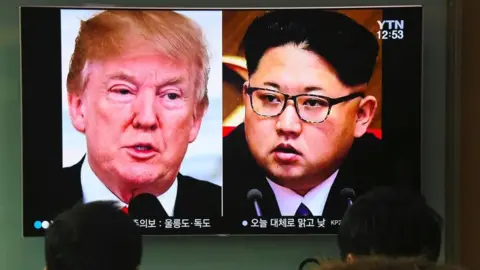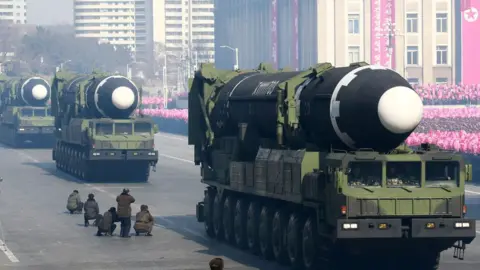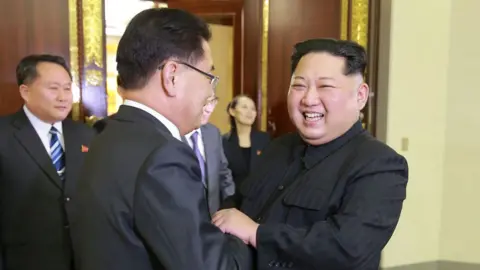US-North Korea talks: What could happen now?
 Getty Images
Getty ImagesUS President Donald Trump has accepted an invitation to meet North Korean leader Kim Jong-un, in what appears to be a breakthrough after months of insults, threats and mutual hostility.
It could happen as early as May which leaves little time to get things organised, from venues to core negotiations. So it's perhaps not surprising that there are many questions about what happens next.
How historic is this?
The talks would be unprecedented, marking the first face-to-face meeting between sitting leaders of North Korea and the US. Former US presidents have met North Korean leaders before, but they were all out of office at that point.
"The [significance of this] could almost be compared to President Nixon meeting China's Chairman Mao, to a lesser degree," analyst Michael Madden of the US-Korea Institute at Johns Hopkins SAIS told the BBC.
What do we know about the actual meeting?
Not much. The White House has confirmed that Trump will meet Kim "by May", but an exact time and location is yet to be determined.
According to Mr Madden, there's a "speculative chance" that the meeting might take place at the North Korean truce village of Panmunjom, which sits at the demilitarised zone between the North and the South.
However, Dr John Park of the Korea Working Group says that he believes the meeting might instead be held "in a neutral location". This could be in China or elsewhere.
This is the first time the US has been in direct talks with North Korea about its nuclear program since 2012. Kim Jong-un has never met another foreign leader until now, though he is scheduled to meet South Korean leader Moon Jae-in in April at Panmunjom.
What will be discussed?
Denuclearisation will undoubtedly be the biggest issue that the meeting will hope to address.
But while Mr Kim says he is "committed to denuclearisation", North Korea has not yet promised to abandon its nuclear weapons completely.
"The US will be pushing for total denuclearisation and South Korea has also said that it is their main objective," said Bruce Bennett, an analyst at the RAND Corporation.
"But it's important to remember that Mr Kim has said over and over again that they will not give up their nuclear weapons."
 Getty Images
Getty ImagesOther points that might be brought up are: US pushing for Americans held in Pyongyang to be brought home, North Korea looking for recognition as a nuclear-capable state and a possible peace treaty being signed.
"A peace treaty would give North Korea reassurance and deprive them of one of the key rationales behind their nuclear program [that they have to defend themselves]," said Mr Madden.
But one of the terms of a potential peace treaty could be the withdrawal of US troops from South Korea, a move which could prove deeply problematic.
"I think Mr Kim anticipates that if a peace treaty is signed, that after say 10 years most of the US troops in South Korea could be withdrawn," said Mr Bennett.
"Then maybe if later on he then wanted to forcefully reunify South Korea, [it would be easier] as the US troops would be gone. This would be the safest way to reach his objective."
What will happen to sanctions?
Analysts agree that it is hard to predict the extent to which sanctions will be lifted or eased, adding that it is dependent on how successful the talks are.
"North Korea is definitely looking for sanctions relief, that will be a key demand of theirs," said Mr Bennett. "The question is, would we lift sanctions in an incremental manner or are we going to insist on total denuclearisation before we lift?"
Mr Bennett also believes that the harsh sanctions placed on North Korea had real effect in bringing them to the table.
"There were reports that North Korea was going to possibly run out of hard currency by this October. So I think the campaign was really causing some pain in the North."
What would a successful meeting look like?
A successful meeting would see an "agreement" being signed by all parties, according to Mr Madden.
"If they can reach a point that has certain tangible achievements, like North Korea agreeing to a freeze in nuclear test activities and letting international inspectors in to the country to view their nuclear facilities that would be a success," said Mr Madden.
But Mr Bennett argues that it is more likely that both sides would reach a compromise where they had "given things up but also gained".
What is the worst case scenario?
"The worst case scenario is North Korea walking out of talks and claiming it's because Trump is being totally unresponsive and the US is being difficult," said Mr Bennett.
 Getty Images
Getty ImagesBut a more plausible scenario is the US and North Korea simply failing to make any progress at all.
"I call it the 'kick the can down the road' policy, we just delay discussing this until further down the line with another US President," said Mr Bennett.
"By say 2030, North Korea could have 200 nuclear weapons and what happens then if they force the South to surrender? If we kick the can again we're going to have a bigger problem a few years down the road."
